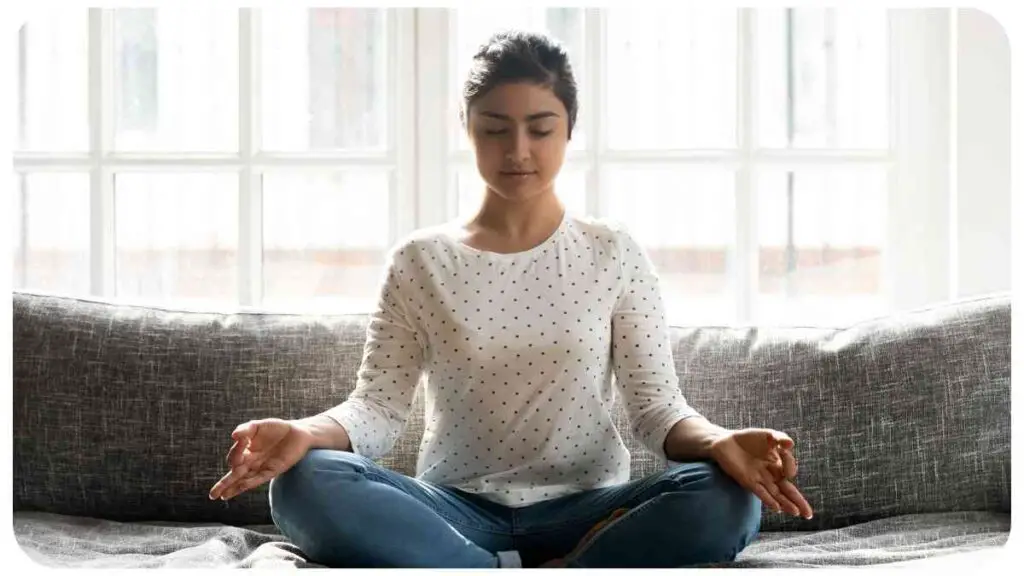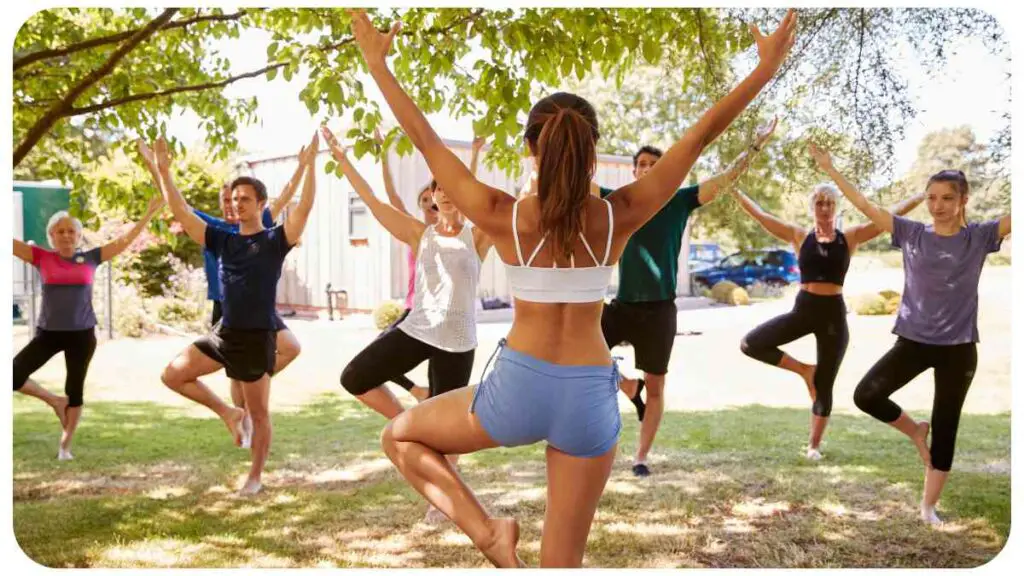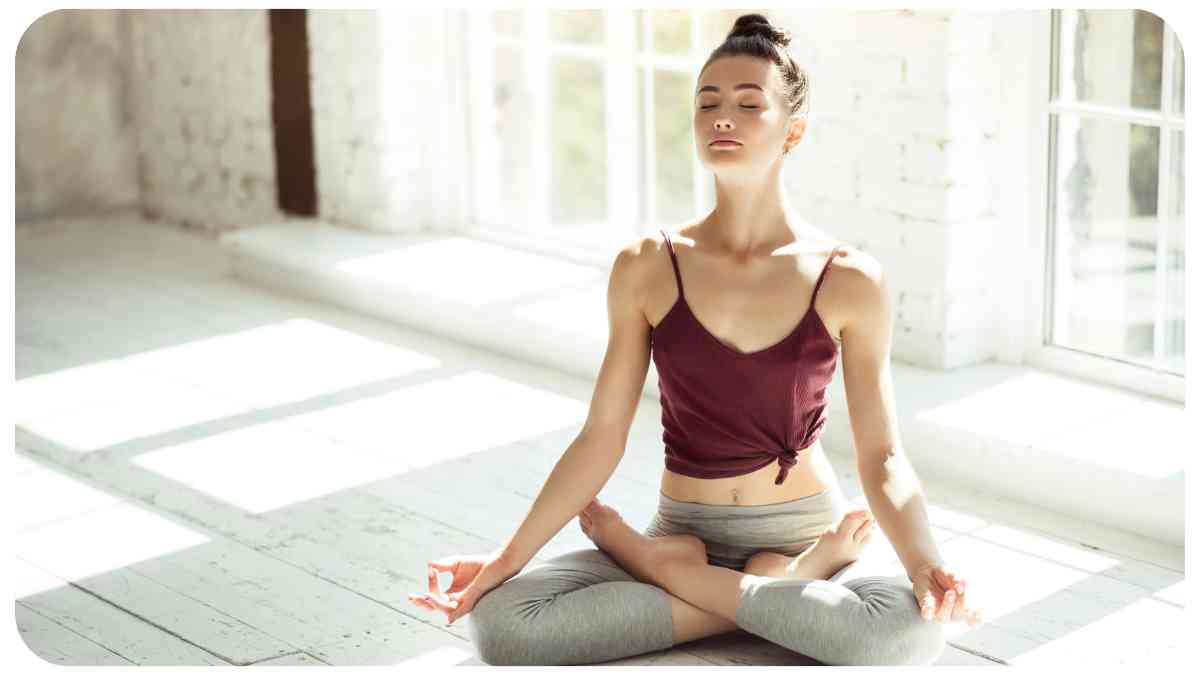Let’s inhale, shall we? And exhale… Feels simple enough, right? Well, as simple as breathing may seem, it’s a significant aspect of yoga that often goes unnoticed. Just like the subtle undercurrent in a vast river, yoga breathing, also known as pranayama, is the life force that drives the entire practice.
If you’ve been curious about how yoga breathing techniques could enhance your routine, or if you’ve just started and feel a bit lost, don’t worry – you’re in the right place.
| Key Takeaways |
|---|
| Understanding the crucial role of pranayama (breathing) in yoga |
| Learning about the various types of yoga breathing techniques |
| Realizing the pros, such as stress relief and improved focus, of yoga breathing |
| Acknowledging the potential cons, like physical discomfort and hyperventilation, of yoga breathing |
| Grasping essential tips for beginners starting yoga breathing practices |
| Gaining insights into the positive impacts of yoga breathing on mental and physical health |
| Avoiding common mistakes in yoga breathing practices |
| Importance of selecting the right yoga breathing technique based on individual needs |
| Glimpse into the realm of advanced breathing techniques |
| Understanding the vital role of a yoga instructor in mastering breathing techniques |
| Encouragement to see yoga breathing as a journey of self-discovery |
Understanding Yoga Breathing
Breathing in yoga, or pranayama, is far more than just inhaling and exhaling. It’s a harmonious balance of calming the mind, controlling the body, and connecting with the soul. It’s a conscious control of breath that helps to regulate the flow of prana, or life force, throughout your body.
Building a strong connection to your own spirituality is essential for a fulfilling yoga practice. Discover how to tap into the deeper meaning of your practice and enhance your spiritual journey.
Why Is Breathing in Yoga Important?
A key component of any yoga practice, pranayama, aids in focusing the mind and attuning to the body’s needs. The rhythmic flow of breath can calm the nervous system, reduce stress, and enhance overall well-being. It’s the silent conductor orchestrating the symphony of movements that we perform during a yoga routine.
Types of Yoga Breathing Techniques
There’s a diverse range of yoga breathing techniques, each with its unique rhythm, method, and purpose. Let’s take a look at a few popular ones.
Ujjayi Breathing

Known as the ‘Victorious Breath’ or ‘Ocean Breath,’ Ujjayi breathing is characterized by an audible, soothing sound, much like the waves of the ocean. This technique involves both nostril and throat breathing, which can provide a warming effect and help you stay focused during your practice.
Alternate Nostril Breathing (Nadi Shodhana)
Nadi Shodhana, or alternate nostril breathing, is a peaceful technique that involves alternating the nostril you breathe through. It’s said to balance the left and right hemispheres of the brain, bringing about a state of mental clarity and calm.
Yoga has the power to unlock ancient practices that lead to ultimate enlightenment. Explore the secrets of ancient yoga practices for ultimate enlightenment and embark on a transformative journey of self-discovery.
Belly Breathing (Diaphragmatic Breathing)
As the name suggests, belly breathing focuses on the diaphragm, promoting deep abdominal breathing rather than shallow chest breathing. This technique can improve lung capacity and promote relaxation.
Lion’s Breath (Simhasana)
Simhasana, or Lion’s Breath, is an energizing technique that can help relieve tension in the face and chest. It involves inhaling deeply through the nose and exhaling forcefully through the mouth, sticking out the tongue.
Pros of Yoga Breathing Techniques
Practicing yoga breathing techniques can have numerous benefits. Let’s explore some of these advantages:
- Improved Focus: Techniques like Ujjayi breath can help enhance mental clarity, promoting a greater sense of mindfulness.
- Stress Relief: Practices such as alternate nostril breathing are known for their stress-reducing effects.
- Enhanced Lung Capacity: Deep breathing techniques, such as diaphragmatic breathing, can help improve lung function and capacity.
- Increased Energy Levels: Some techniques like Lion’s breath can invigorate the body, boosting your overall energy levels.
| Breathing Technique | Key Benefits |
| Ujjayi | Improved focus, stress relief |
| Nadi Shodhana | Stress relief, improved emotional wellbeing |
| Diaphragmatic Breathing | Enhanced lung capacity, improved respiratory function |
| Lion’s Breath | Reduced tension, increased energy levels |
Cons of Yoga Breathing Techniques
While yoga breathing techniques can be immensely beneficial, they may not be suitable for everyone:
- Potential Hyperventilation: Overdoing breathing exercises, particularly forceful techniques, can lead to hyperventilation or dizziness in some people.
- Physical Discomfort: Some people may experience discomfort or pain when attempting certain techniques, especially without proper guidance.
- Medical Considerations: Individuals with respiratory issues or heart conditions should consult with a healthcare professional before starting any new breathing exercises.
Combining yoga and meditation can bring you closer to spiritual enlightenment. Learn how to merge the two practices in perfect harmony with our guide on yoga and meditation for spiritual enlightenment and experience profound inner growth.
How To Start Practicing Yoga Breathing

Getting started with yoga breathing techniques doesn’t have to be intimidating. Here are some simple steps to begin your journey:
Find a Comfortable Space
Find a quiet, comfortable space where you won’t be disturbed. This could be a dedicated yoga room, a corner of your living room, or even a spot outdoors where you feel at peace.
Warm-up Exercises
Engage in a few warm-up exercises to prepare your body. This could include gentle neck and shoulder rolls or simple stretches.
Follow a Guided Practice
As a beginner, following a guided practice can be immensely helpful. There are plenty of resources available online, from detailed articles to video tutorials, that can guide you through each technique.
Yoga not only benefits the body but also nurtures the spirit. Delve into the spiritual realm and explore the benefits of yoga in connecting with your higher self for a deeper sense of self-awareness and connection.
Tips for Beginners
If you’re new to yoga breathing, here are some tips that might help:
- Start Slow: Don’t rush into advanced techniques. Begin with basic ones like belly breathing and gradually move onto others.
- Be Consistent: Regular practice is key. Try to set aside a few minutes each day for pranayama.
- Listen to Your Body: If a technique makes you feel dizzy or uncomfortable, stop and resume normal breathing. Always respect your body’s signals.
Understanding the Impact of Yoga Breathing on Health
Yoga breathing techniques can have profound effects on both mental and physical health.
Effects on Mental Health
Breathing exercises are known for their calming effects. They can reduce stress, anxiety, and improve sleep quality. Certain techniques can even help in managing symptoms of post-traumatic stress disorder (PTSD).
Effects on Physical Health
Physically, yoga breathing can enhance lung capacity, improve respiratory function, and may even have positive effects on cardiovascular health. It’s also a great way to warm up and prepare the body for a yoga sequence.
Mindfulness is a powerful tool that can improve overall wellness. Discover the transformative effects of mindfulness in our comprehensive guide on how mindfulness can improve your wellness, and enhance your physical, mental, and emotional well-being.
Common Mistakes and How to Avoid Them
There are a few common mistakes that beginners might make when starting with yoga breathing techniques:
- Shallow Breathing: Focus on deep, diaphragmatic breathing rather than shallow chest breathing.
- Forcing the Breath: Never strain or force your breath. It should flow effortlessly.
- Rushing Through: Take your time with each breath. Yoga breathing should be a mindful practice, not a rushed task.
| Common Mistakes | Tips to Avoid |
| Shallow Breathing | Focus on deep, diaphragmatic breathing |
| Forcing the Breath | Allow the breath to flow naturally |
| Rushing Through | Take your time with each breath |
Selecting a Yoga Breathing Technique That’s Right for You
Choosing the right yoga breathing technique depends on your individual needs, preferences, and physical condition. For instance, if you’re seeking relaxation and stress relief, alternate nostril breathing or belly breathing might be beneficial. If you need to energize yourself, you might find Lion’s breath more suitable. Consulting a yoga instructor or a healthcare professional could be helpful in making an informed choice.
A Glimpse into Advanced Breathing Techniques
Once you’ve mastered the basic techniques, you might want to explore more advanced forms of pranayama such as Kapalabhati (Skull Shining Breath) or Bhastrika (Bellows Breath). Remember, these advanced techniques should always be practiced under the guidance of a trained professional.
The Role of a Yoga Instructor

A certified yoga instructor can provide invaluable guidance, especially when you’re just starting out. They can correct your form, suggest modifications, and help you progress safely. They can also help you understand the subtle aspects of pranayama, enhancing your overall yoga experience.
The Journey Beyond
Yoga breathing is more than just a physical exercise; it’s a journey of self-discovery. As you delve deeper into pranayama, you’ll likely discover it to be a powerful tool for mindfulness, a pathway that leads you towards greater self-awareness and inner peace.
Conclusion
Yoga is not just about bending and twisting the body; it’s equally about bending and twisting the breath. Pranayama, or the art of yogic breathing, has the power to calm the mind, nourish the body, and uplift the spirit. Whether you’re seeking stress relief, better respiratory health, or a deeper connection with your inner self, yoga breathing techniques can offer a pathway.
This journey of yoga breathing may start with a single breath, but it extends far beyond, leading you to unexplored realms of tranquility and resilience. While the road may seem daunting at first, remember that every expert was once a beginner. It’s okay to take small steps. It’s okay to stumble and rise again. As long as you’re moving forward, you’re on the right path.
As we conclude, let’s revisit the essence of our discussion through a quick table:
| Key Takeaways from the Article |
| Understanding the importance of breathing in yoga |
| Introduction to various yoga breathing techniques |
| Pros and cons of yoga breathing |
| Tips and guidance for beginners |
| Role of a yoga instructor in mastering the techniques |
| Glimpse into advanced breathing techniques |
So, are you ready to begin your journey? Just remember – breathe easy, stay calm, and enjoy the process. As they say in yoga, it’s about the journey, not the destination.

Hello, my name is Hellen James! I am a yoga teacher and writer who loves to share information about how you can achieve a more fulfilling life. I have been practicing mindfulness, yoga, and meditation for over 10 years. My passion for these practices has led me to teach them to others.

